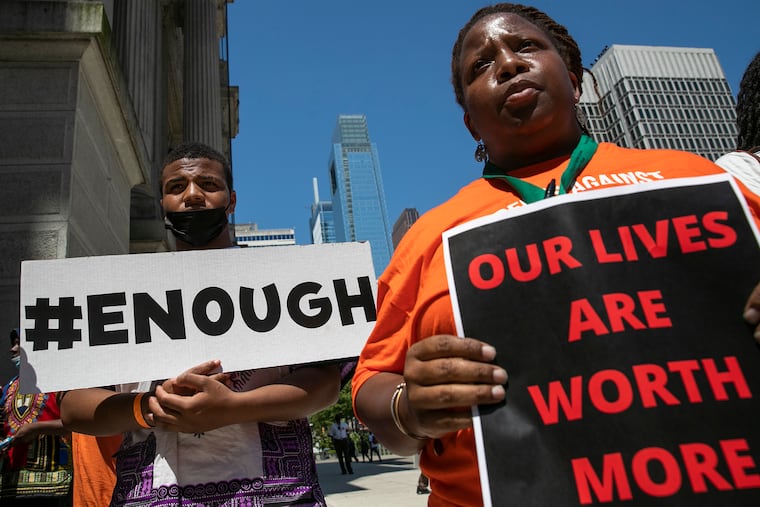Gun violence isn’t inevitable. It’s a policy choice.
To move faster to address gun violence, we can’t rely mostly on prevention. We also have to work on deterrence, so people don’t bring guns to disputes.

After the mass murders at Robb Elementary School in Uvalde, Texas, Buffalo, N.Y., and the ongoing violence in our city (including the deaths of three people on South Street last weekend), it feels like our nation’s gun violence problem has a depressing inevitability. These issues are not, however, inevitable. They are a policy choice.
The U.S. does not have one gun problem, but many. We lead the world in firearm suicides, are No. 1 in mass shootings, and more than half of all domestic violence homicides in this country are committed with a gun.
In terms of the shooting on South Street, initial reports suggest the shooting began after a fight. If so, this would make it an example of a fourth problem: community gun violence. This can happen as a result of the illicit drug trade, or long-standing feuds.
» READ MORE: The mass shooting on South Street is a stark reminder of Philly’s thwarted efforts to tighten gun laws | Editorial
Other community gun violence events are less predictable and result from spontaneous arguments between people who don’t know each other, like road-rage incidents.
It’s human nature to argue. We can’t prevent long-standing feuds or spontaneous arguments between strangers. These only become fatal because the participants have guns.
America has more armed civilians than any other country — more than the next 25 countries combined. And in Philadelphia, it appears that more people are carrying guns in public. While police stops (traffic and pedestrian) have dropped to about a quarter of their recent peak in 2019, the number of firearms recovered by police has increased. Either police officers have drastically improved their ability to spot concealed weapons, or we are witnessing a major increase in the number of people carrying guns in the city.
Why do people carry and use guns? Usually, because they feel at risk. This points to two potential ways to convince them to stop carrying guns: prevention (making them feel safer so they don’t need to carry guns) and deterrence (increasing the perceived risk of being caught and prosecuted with an illegal gun).
With the election of Mayor Jim Kenney and District Attorney Larry Krasner, Philadelphia chose the former approach. Right now, the city is adopting a public health approach that stresses long-term prevention and de-emphasizes deterrence (such as police intervention and prosecution). City Controller Rebecca Rhynhart’s office has estimated that the vast majority of the financial year 2022 anti-violence budget was allocated to prevention and “transformation” funding, which targets root causes of violence such as poverty, and could take up to 20 years to see effects.
“Twenty years is too long to wait before we see change.”
All of this is sorely needed. But it’s not enough. Because 20 years is too long to wait before we see change. This is a personal problem for every resident of Philadelphia. I live half a block off of South Street, but every day, gunfire rings out from many corners of the city.
As I said, we have many gun problems, and all would benefit from one intervention: reducing the volume and ease of access to guns in America. But until we can do that, and move faster to address gun violence, we can’t rely mostly on prevention. We also have to work on deterrence, which can address some of the less predictable shootings that plague so many neighborhoods.
We know from research that foot patrol, adding police to high-crime spots, a focus on serious repeat offenders, and using police to solve long-standing problems that are leading to crime (known as problem-oriented policing) can all provide communities with some respite from violence until longer-term strategies mature. Deterrence may also involve more prosecutions of gun offenses, such as carrying a “ghost gun” like the one used on South Street.
Our leaders’ reticence to engage in proven strategies stems from the realization that when we implement deterrence efforts in the places where they are most needed, they are not racially equitable. But that doesn’t change the fact that these measures work. Black and brown Philadelphians shouldn’t be made to feel like they are overpoliced. Equally though, they shouldn’t be made to feel less safe than white residents. But that is exactly what is happening: More than 90% of people shot so far this year are Black or Hispanic, and it is their communities who are bearing the brunt of our failure to find a balanced approach to gun violence.
In the past, we have relied too heavily on policing as our solution to violence reduction. But we don’t want to cut back too much, either. On-the-ground policing, if conducted with fairness and transparency, can reduce some of the bloodshed we are seeing, and also help prevent violence from happening.
One thing is for sure: What we are doing now isn’t working.
Jerry Ratcliffe is a professor of criminal justice at Temple University and host of the “Reducing Crime” podcast.